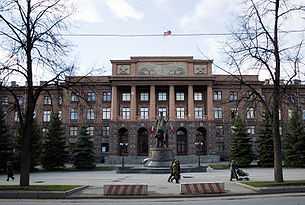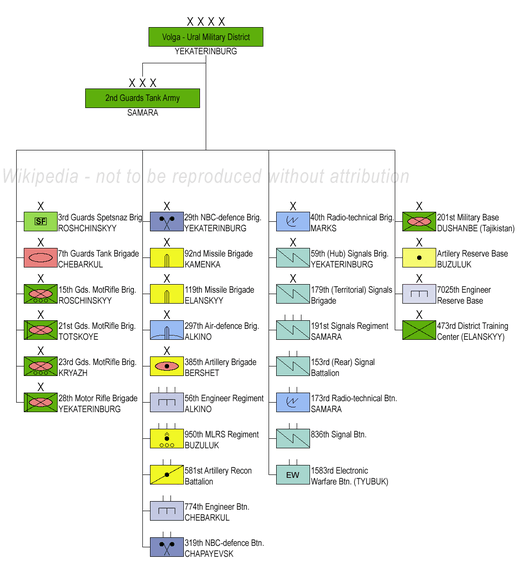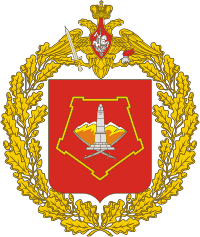Volga–Urals Military District
| Volga–Ural Military District Приволжско-Уральский военный округ | |
|---|---|
|
Volga–Ural Military District Coat of Arms | |
| Active | September 1, 1989-2010 |
| Country |
|
| Branch | Russian Ground Forces |
| Type | Military district |
| Headquarters | Yekaterinburg |
| Decorations |
 Order of the Red Banner |
| Commanders | |
| Commander of Troops of the Volga–Ural Military District | General-Polkovnik Arkady Bakhin |
The Volga–Ural Military District was a military district of the Russian Ground Forces, formed on 1 September 2001 by the amalgamation of the Volga Military District and the Ural Military District. The headquarters of the Ural Military District, located at Yekaterinburg became the new headquarters of the merged district. In 2010 the District was merged with part of the Siberian Military District to form the new Central Military District.
Origins
The new merged district draws upon the history of the former Ural, Volga, and Kazan Military Districts.[1] The Kazan Military District was first to be formed in the Volga province of the Russian Empire, by order of the Defence Minister of 6 August 1864, as one of fifteen military districts being formed. Each district was intended to command combat formations, as well as act as a military-administrative organ on a regional scale - 'the War Ministry on a local level'. The Kazan Military District, with its headquarters in Kazan, took in the Orenburg, Kazan, and Ufa provinces, part of the Perm province, and the Ural and Turgay regions. In 1911, the 16th and 24th Army Corps were formed in the district, and just before the First World War, the district's staff was reorganised as the 4th Army.
Following the October Revolution, the staff of the old imperial military districts hindered the creation of the new Soviet Red Army, and to surmount this, a new structure was established on 31 March 1918, including the creation of the new Volga and Ural Military Districts. Much of the fighting in the Russian Civil War took place on the districts' territory. The official Russian Defence Ministry site notes the combat actions of the 20th, 21st, 24th, 25th, 26th, and 27th Rifle Divisions which took place on the eastern front of the war, as well as other formations and units.
After the end of the Civil War the armed forces were reduced and the Ural Military District disbanded, on 21 April 1922. It was reformed on 17 May 1935 with its staff located at Sverdlovsk, amid the international tensions caused by the Nazis' rise to power in Germany and the Japanese occupation of Manchuria. The 57th Rifle Division of the Volga District and the 82nd Rifle Division from the Urals were involved in the Battle of Khalkhin Gol with the Japanese in 1939.
World War II


During World War II the two districts dispatched over three thousand units to the front, totaling two million men. Five armies, 132 divisions, and over 300 regiments and battalions were established.
In formation in the Volga Military District alone on 1 September 1941 were the 334, 336, 338, 340, 342, 344, 346, 348, 350, 352, 354, 356, 358, 360th Rifle Divisions, plus the 46th, 89th, and 91st Cavalry Divisions.[2] Among the formations formed during the war was the 153rd Ural Rifle Division, which for its combat record in Belorussia and Smolensk was ranked among the Guards' on 18 September 1941 as the 3rd Guards Rifle Division. Also formed in the Ural District, with the tremendous effort of factory workers there, was the 30th Ural Tank Corps, later to become the 10th Urals-Lvov Tank Corps, today the 10th Guards Uralsko-Lvovskaya Tank Division within the Moscow Military District.
During the war, the city of Kuybyshev (now Samara) served as the alternate capital of the Soviet Union, and the Urals area became the biggest arsenal in the country, with many factories relocated from the west. The 3rd Guards Army arrived from Germany and was redesignated as the new Volga MD headquarters in late 1945. As part of the massive demobilisation exercise of 1945-6 the Kazan Military District was briefly reformed, encompassing the Tatar, Udmurt, Mari and Chuvash ASSRs.
During the Cold War the district's air forces included the Chelyabinsk Higher Military Aviation School for Navigators.
Postwar
The Ural Military District was commanded between 1948 and 1953 by Marshal Georgi Zhukov, effectively 'exiled' from more important commands.
In June 1957 the 4th Rifle Division at Buzuluk was converted into the 4th Motor Rifle Division, but along with numerous other new motor rifle divisions, it was disbanded later, in 1959.[3]
By a Decree of the Supreme Soviet of the USSR of 15 January 1974, for their large contributions to the strengthening the defense power of the state and its armed protection both the Volga and Ural military districts were rewarded with the Order of the Red Banner. In 1979 Scott and Scott reported the HQ address of the Ural Military District as Sverdlovsk, K-75, Ulitsa Pervomayskaya, Dom 27, which also housed the officers' club.
On 1 September 1989 the Districts were merged with the new headquarters in Samara. Colonel General Albert Makashov was appointed commander of the district. However in July 1992 the Ural District was reformed, as the region had become a near-boundary area with the new states of Central Asia. The decision on restoration of the two separate Volga and Ural military districts was promulgated in Presidential Decree № 757 of 7 July 1992 and the Order of the Minister of Defence of 25 July 1992.
From 1992 the two districts received large numbers of units and formations returning from the former groups of forces (including the Second Guards Tank Army, and the 16th[4] and 90th Guards Tank Divisions from the Group of Soviet Forces in Germany) and the ex-Soviet republics, the reception of which required enormous effort on behalf of the District HQs and the regional administrations. Many of these units were subsequently disbanded, including the 15th Guards Tank Division, the former 15th Guards Cavalry Division (withdrawn from the Central Group of Forces), which for much of the 1990s and early 21st century was at Chebarkul and only disbanded in 2004-5.
In 2009, the Ulyanovsk arms depot explosion happened just before a visit from President Dmitry Medvedev.[5] Four military officers, including the deputy commander of the Volga–Ural Military District for armaments, General Major V. G. Khalitov, were dismissed for 'lack of control' and 'criminal negligence.'[6]
In 2006-07 the district's troops comprised:
- 34th Motor Rifle Division, Yekaterinburg. Military Unit No. 45463. Includes elements of the former 15th Guards TD. Divisional honorifics 'Simferopol Red Banner, Order of Suvorov named for S. Ordzhonikidze.' Structure in 1989-90 included the 341st TR, 105, 276, 324 MRR, and the 239 Arty Regt. Until 1955 the division was designated the 77th Rifle Division; 1957 became 126th MRD; 1965 became 34th MRD.[7] On 1 March 2009 renamed 28th Motor Rifle Brigade.
- Russian 201st Motor Rifle Division, Dushanbe, Tajikistan
- 15th Separate Motor Rifle Brigade (which took part in the command post peacekeeping Exercise Normandie-Nieman 07 in April 2007 with the 1st Mechanised Brigade (France))[8]
- 2nd Army, Samara (formerly headquarters Ural Military District)(history closely associated with 2nd Guards Tank Army)
- 5th Air Army of VVS and PVO
- other formations and units
Subordinate Units

Red Banner Volga–Ural Military District 2010:[9][10]
- Combat formations:
- 7th Guards Independent Tank Brigade "Orenburg Cossacks", in Chebarkul
- 15th Guards Independent Motor-Rifle Brigade "Berlin", in Roshchinsky, Samara Oblast equipped with BTR.[11] Military Unit # 90600. Honorifics Berlin Red Banner Order of Kutuzov. Specialised 'peacekeeping' unit. Address: 443539, Samara distr, Roschinskyy. Former 589 ind mot rifle rgt. 2005: 100% contract service. 04.2008 visited by Japanese defence minister. 08.2008 one unit took part in war in South Ossetia.
- 21st Guards Independent Motor-Rifle Brigade "Omsk-Novoburg", in Totskoye equipped with BMP
- 23rd Guards Independent Motor-Rifle Brigade "Petrakuvskaya", in Kryazh equipped with BTR
- 28th Independent Motor-Rifle Brigade "Simferopol", in Yekaterinburg equipped with BMP[12]
- 201st Military Base "Gatchinskaya", in Dushanbe (Tajikistan)
- 3rd Guards Spetsnaz Brigade "Warsaw-Berlin", in Roshchinsky, Samara Oblast
- 473rd District Training Center, in Elanskyy (just west of Kamyshlov in Sverdlovsk Oblast
- 31st Guard Independent Airborne Brigade, in Ulyanovsk (under command of the Russian Airborne Troops (VDV) Command in Moscow)
- Missile and Artillery formations:
- Air-defence formations:
- 297th Air-defence Missile Brigade, in Alkino-2 (Ufa) equipped with the Buk missile system
- Radar formations:
- Engineering formations:
- 56th Engineer Regiment, in Alkino
- 774th Independent Engineer Battalion, in Chebarkul
- 7025th Engineer Reserve Base
- NBC-defence formations:
- 29th Independent NBC-defence Brigade, in Yekaterinburg
- 319th Independent NBC-defence Battalion, in Chpayevsk
- Signal formations:
- 59th (Communications Hub) Signal Brigade "Sivashskaya", in Yekaterinburg
- 179th (Territorial) Signal Brigade
- 191st Independent Signal Regiment, in Samara
- 153rd Independent (Rear) Signal Battalion
- 836th Independent Signal Battalion
- 1583rd Independent Electronic Warfare Battalion
Today the District comprises the Republic of Bashkortostan, the Republic of Mari El, the Republic of Mordovia, the Republic of Tatarstan, the Udmurt Republic, the Chuvash Republic, Kirov, Kurgan, Orenburg, Penza, Perm, Samara, Sverdlovsk, Tyumen, Ulyanovsk, and Chelyabinsk Oblasts, and the Komi-Permyak, Khanty-Mansiysk, and Yamalo-Nenets Autonomous Okrugs.
It was reported that the District was dissolved on September 1, 2010, with most of its area of responsibility combined with the Siberian Military District as part of the new Central Operational-Strategic Command, while its western part joined the Southern Operational-Strategic Command (formerly the North Caucasus Military District).
Volga–Ural Military District Commanders
1989–1992
- 1989–1991: General-Colonel A.M. Makashov,
- 1991–1992: General-Colonel A.I. Sergeyev
2001–present
- 2001–2004: General-Colonel (General of the Army from June 2004) A.I. Baranov,
- 2005–2008: General of the Army V.A. Boldyrev,
- 2008–present: General-Lieutenant A.V. Bakhin
References
- ↑ Official Russian Defence Ministry website, www.mil.ru
- ↑ tashv.nm.ru, Combat composition of the Soviet Army, 1 September 1941, accessed October 2011
- ↑ Michael Holm, 4th Motor Rifle Division, 2015.
- ↑ http://specnaz.pbworks.com/w/page/17657926/18%20%D0%BF%D1%83%D0%BB%D0%B0%D0%B4
- ↑ Lucien Kim, Russian Army Reclaims 'Abandoned' Tanks After Internet Exposure, Bloomberg.com 28 February 2010
- ↑ Medvedev fires military officials after Ulyanovsk arms depot blasts, 24 November 2009 and http://www.webground.su/tema/2009/11/25/6/
- ↑ Michael Holm, http://www.ww2.dk/new/army/msd/34msd.htm
- ↑ French Army, Terre Information Magazine, No.185, June 2007, p.7
- ↑ http://gov.cap.ru/hierarhy.asp?page=./5016/12937/558172/648775/648833
- ↑ http://gov.cap.ru/list4/news/rec.aspx?gov_id=657&pos=1&id=971618
- ↑ http://www.roshinskiy.ru/page.php?id=24
- ↑ See for confirmation http://chk.ekburg.ru/43/1958/, accessed September 2009. See also http://www.redstar.ru/2009/10/07_10/2_02.html
- Scott and Scott, The Armed Forces of the USSR, Westview Press, Boulder, Co., 1979
- Feskov,, V.I.; K.A. Kalashnikov, V.I. Golikov. (2004). The Soviet Army in the Years of the 'Cold War' (1945-1991). Tomsk: Tomsk University Press. ISBN 5-7511-1819-7.
- https://fas.org/irp/world/russia/fbis/VolgaMD.htm
- http://www.webcitation.org/query?url=http://www.geocities.com/pentagon/9059/RussianArmedForces.html&date=2009-10-22+23:33:20
- See also VUMD at Warfare.ru
| ||||||
